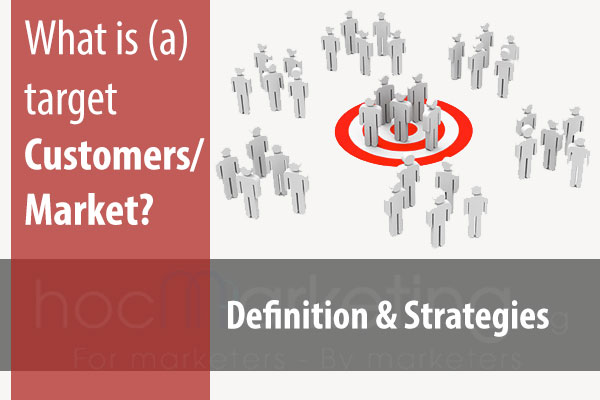
What is target customer/target market? How to select a target market (market targetting)?

What is target customers (a target market)? How to select a target market (market targetting)? Popular market-targeting strategies. Factors should be considered before choosing a market-targeting strategy
Definition of target customer/target market
Target customers, which can be called a target market, is the collection of all customers that a firm has clearly identified through the market segmentation. They are targeted by the firm to be converted into its actual customers. Of course, these are customers who have needs which can be satisfied by the firm's marketing offerings and are able to pay for those offerings.
Examples of target customers (a target market):
- Firm A’s target customers are 16-40 years old, male and who regularly engage in sports activities and live in America.
- Bank B's target customers are the business men or the business women, who are 25-50 years old and they often have a need for loans and live in Texas.
- Enterprise C's target market includes footwear manufacturing companies in over the world.
Roles of target customer in marketing
Target customers, or a target market, play(s) a center role in all Marketing strategies, plans and activities. Firms and marketers always try to provide products/services based on the needs of target customers, pricing based on their ability to pay and a distribution channel based on the location of the target customers.
The final goal of marketing is providing value to target customers through marketing offerings and capturing value from those customers in return.
Identifying a firm's target customers (target market)
A firm can identify its target customers (target market) by following steps:
- Market research: The firm conducts research with the purpose of determining the number of customers with needs that the enterprise can satisfy as well as the number and size of competitors that can meet that demand.
- Market segmentation: The firm divides the market into many segments (a collection of customers who share one or more common characteristics).
- Market targeting: The firm chooses (a) segment(s) as its target market.
Market targeting strategies
A market targeting strategy is a strategy or tatic in which a firm choose (a) market segment(s) as its target market to serve in order to achieve its marketing goals.
There are 4 market targeting strategies used popularly by firms: Mass marketing, Segmented marketing, Niche marketing and Micro marketing.
1. Mass marketing
Mass marketing (undifferentiated marketing) is a market targeting strategy in which a firm decides to ignore market segment differences and offer the same marketing offerings to all customers.
When using the strategy, a firm tries to exploit what is common in the needs of consumers rather than on what is different. Products and marketing programs are designed so that will appeal to the largest number of buyers.
The strategy is rarely used by firms nowadays, which can be only seen in a monopoly market in some countries. For example: The electricity market in Vietnam (EVN), the oil market in North Korea... Most modern marketers have strong doubts about this strategy. Difficulties arise in developing a product or brand that will satisfy all consumers. Moreover, mass marketers often have trouble competing with more-focused firms that do a better job of satisfying the needs of specific segments and niches.
2. Segmented marketing
A segmented marketing (or differentiated marketing) is a market-targeting strategy in which a firm decides to target several market segments and designs differentiated marketing offerings for each.
For example, P&G markets at least six different laundry detergent brands in the United States (Tide, Gain, Cheer, Era, Dreft, and Bold), which compete with each other on supermarket shelves. Then P&G further segments each detergent brand to serve even narrower niches. For example, you can buy any of dozens of versions of Tide—from Tide Original, Tide Coldwater, or Tide Pods to Tide Free & Gentle, Tide Vivid White + Bright, Tide Colorguard, Tide plus Febreze, or Tide with a Touch of Downy.
By offering product and marketing variations to segments, companies hope for higher sales and a stronger position within each market segment. Developing a stronger position within several segments creates more total sales than undifferentiated marketing across all segments. Thanks to its differentiated approach, P&G is really cleaning up in the $15 billion U.S. laundry detergent market. Incredibly, by itself, the Tide family of brands captures a 38 percent share of all North American detergent sales; the Gain brand pulls in another 15 percent. Even more incredible, all P&G detergent brands combined capture a 60 percent U.S. market share.
But differentiated marketing also increases the costs of doing business. A firm usually finds it more expensive to develop and produce, say, 10 units of 10 different products than 100 units of a single product. Developing separate marketing plans for separate segments requires extra marketing research, forecasting, sales analysis, promotion planning, and channel management. And trying to reach different market segments with different advertising campaigns increases promotion costs. Thus, the company must weigh increased sales against increased costs when deciding on a differentiated marketing strategy.
3. Niche marketing
Niche marketing (or concentrated marketing) is a market-targeting strategy in which a firm chooses a few small but profitable segments or niches instead of going after many segments or a large share of the gross market.
For example, consider nicher Stance Socks:
“Rihanna designs them, Jay Z sings about them, and the rest of the world can’t seem to get enough of Stance socks,” says one observer. They’ve even become the official on-court sock of the NBA and a favorite of many professional players on game day. Nicher Stance sells socks and only socks. Yet it’s thriving in the shadows of much larger competitors who sell socks mostly as a sideline. Five years ago, Stance’s founders discovered socks as a large but largely overlooked and undervalued market. While walking through the sock section a local Target store, says Stance’s CEO and cofounder, Jeff Kearl, “It was like, black, white, brown, and gray— with some argyle—in plastic bags. I thought, we could totally [reinvent] socks, because everyone was ignoring them.”
So Stance set out to breathe new life into the sock category by creating technically superior socks that also offered fun, style, and status. Mission accomplished. You’ll now find colorful displays of Stance’s comfortable but quirky socks in stores in more than 40 countries, from the local surf shop to Foot Locker to Nordstrom, Bloomingdale’s, and Macy’s. Selling at prices ranging from $10 to $40 a pair, Stance sold an estimated 12 million pairs of socks last year. That’s small potatoes for giant competitors such as Hanes or Nike, but it’s nicely profitable for nicher Stance. Next up? Another often overlooked niche—Stance men’s underwear.
Through concentrated marketing, the firm achieves a strong market position because of its greater knowledge of consumer needs in the niches it serves and the special reputation it acquires. It can market more effectively by fine-tuning its products, prices, and programs to the needs of carefully defined segments. It can also market more efficiently, targeting its products or services, channels, and communications programs toward only consumers that it can serve best and most profitably.
Niching lets smaller companies focus their limited resources on serving niches that may be unimportant to or overlooked by larger competitors. Many companies start as nichers to get a foothold against larger, more resourceful competitors and then grow into broader competitors. For example, Southwest Airlines began by serving intrastate, no-frills commuters in Texas but is now one of the nation’s largest airlines. And Enterprise Rent-ACar began by building a network of neighborhood offices rather than competing with Hertz and Avis in airport locations. Enterprise is now the nation’s largest car rental company.
Concentrated marketing can be highly profitable. At the same time, it involves higher-than-normal risks. Companies that rely on one or a few segments for all of their business will suffer greatly if the segment turns sour. Or larger competitors may decide to enter the same segment with greater resources. In fact, many large companies develop or acquire niche brands of their own. For example, Coca-Cola’s Venturing and Emerging Brands unit markets a cooler full of niche beverages. Its brands include Honest Tea (the nation’s number-one organic bottled tea brand), NOS (an energy drink popular among auto enthusiasts), FUZE (a fusion of tea, fruit, and other flavors), Zico (pure premium coconut water), Odwalla (natural beverages and bars that “bring goodness to your life”), Fairlife (unfiltered milk), and many others. Such brands let Coca-Cola compete effectively in smaller, specialized markets, and some will grow into future powerhouse brands.
4. Micromarketing
Micromarketing is a market-targeting strategy in which a firm tailors its marketing offerings to suit the tastes of specific individuals and local customer segments. Rather than seeing a customer in every individual, micromarketers see the individual in every customer. Micromarketing includes local marketing and individual marketing.
Local marketing involves tailoring brands and promotions to the needs and wants of local customers.
For example, Marriott’s Renaissance Hotels has rolled out its Navigator program, which hyper-localizes guest experiences at each of its 155 lifestyle hotels around the world: Renaissance Hotels’ Navigator program puts a personal and local face on each location by “micro-localizing” recommendations for guests’ food, shopping, entertainment, and cultural experiences at each destination. The program is anchored by on-site Renaissance Hotels “Navigators” at each location. Whether it’s Omar Bennett, a restaurant-loving Brooklynite at the Renaissance New York Times Square Hotel, or James Elliott at the St. Pancras Renaissance London Hotel, a history buff and local pub expert, Navigators are extensively trained locals who are deeply passionate about the destination and often have a personal connection to the locale. Based on 100-plus hours of intense training plus their own personal experiences and ongoing research, they work with guests personally to help them experience “the hidden gems throughout the neighborhood of each hotel through the eyes of those who know it best.”
Local marketing has some drawbacks, however. It can drive up manufacturing and marketing costs by reducing the economies of scale. It can also create logistics problems as companies try to meet the varied requirements of different local markets. Still, as companies face increasingly fragmented markets and as new supporting digital technologies develop, the advantages of local marketing often outweigh the drawbacks.
In the extreme, micromarketing becomes individual marketing— tailoring products and marketing programs to the needs and preferences of individual customers. Individual marketing has also been labeled one-to-one marketing, mass customization, and markets-of-one marketing.
Factors should be considered before choosing a market-targeting strategy
Companies need to consider many factors when choosing a market-targeting strategy. Which strategy is best depends on the company’s resources. When the firm’s resources are limited, concentrated marketing makes the most sense. The best strategy also depends on the degree of product variability. Undifferentiated marketing is more suited for uniform products, such as grapefruit or steel. Products that can vary in design, such as cameras and cars, are more suited to differentiation or concentration. The product’s life-cycle stage also must be considered. When a firm introduces a new product, it may be practical to launch one version only, and undifferentiated marketing or concentrated marketing may make the most sense. In the mature stage of the product life cycle, however, differentiated marketing often makes more sense.
Another factor is market variability. If most buyers have the same tastes, buy the same amounts, and react the same way to marketing efforts, undifferentiated marketing is appropriate. Finally, competitors’ marketing strategies should be considered. When competitors use differentiated or concentrated marketing, undifferentiated marketing can be suicidal. Conversely, when competitors use undifferentiated marketing, a firm can gain an advantage by using differentiated or concentrated marketing, focusing on the needs of buyers in specific segments.
Frequently Asked Questions (FAQ)
Target customers, or a target market, play(s) a center role in all Marketing strategies, plans and activities. Firms and marketers always try to provide products/services based on the needs of target customers, pricing based on their ability to pay and a distribution channel based on the location of the target customers.
The final goal of marketing is providing value to target customers through marketing offerings and capturing value from those customers in return.












